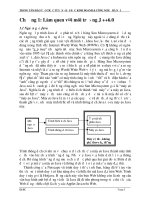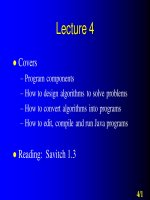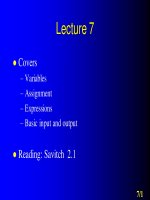Giáo trình Java cơ bản 19
Bạn đang xem bản rút gọn của tài liệu. Xem và tải ngay bản đầy đủ của tài liệu tại đây (489.26 KB, 51 trang )
Lecture 19
Covers
– Methods that return a value
– void methods
– Parameter passing (call-by-value)
Reading: Savitch 4.1
19/1
Example - bank accounts
Create and test a class representing a bank
account that
– Has an id, name, and balance
– Allows a user to deposit, withdraw, and get the
balance
Rules
– Id’s and names must not be missing
– Balance must not be negative (no overdraft)
19/2
Defining class BankAccount
To define the BankAccount class and test
it, we go through the following typical
steps
1.
2.
3.
4.
5.
Sketch
Define
Define
Define
Define
a model of the class
the class header
the attributes
the constructors
the methods
19/3
Sketching a model of the class
BankAccount
class name
String accountNumber
String customerName
double balance
attributes
BankAccount(String accNo, String custName)
void deposit(double amount)
void withdraw(double amount)
methods
double getBalance( )
String toString( )
19/4
Specifying the class header
public class BankAccount
{
}
19/5
Declaring the attributes
public class BankAccount
{
private String accountNumber;
private String customerName;
private double balance;
}
19/6
Defining the constructors
public BankAccount(String accNo, String custName)
{
accountNumber = accNo;
customerName = custName;
balance = 0;
}
19/7
Defining the methods
To make a deposit
To withdraw money
To get the balance
To display a BankAccount object
19/8
Method to get the balance
public double getBalance( )
{
return balance;
}
19/9
Methods that return a value
Sometimes a method’s invocation should
result in a value being sent back to the
sender of the invoking message
When a method is expected to send a result
back to the sender, it is said to return a
value
Each method must define a return type, i.e.
the type of the value it sends back
19/10
Methods that return a value
A method may have many variables and
attributes with which it works, and many
calculations it performs
The method has to specify which value or
calculation it sends back
This is called the return value
19/11
Methods that return a value
A return value is specified by a return
statement
In the previous example, balance was the
return value, so therefore, the value stored
in the balance attribute of the object is sent
back as the result of the method’s
invocation
19/12
Methods that return a value
Processing of a method terminates at a
return statement
The value specified by the return statement
is returned to the call site (the place in the
program that invoked the method)
When a method terminates, processing in
the program then continues at the call site
19/13
Method to make deposits
public void deposit(double amount)
{
if (amount <= 0)
{
System.out.println(amount + " is not a valid deposit!");
return;
}
else
{
balance = balance + amount;
}
}
19/14
void methods
Sometimes a method is not expected to
return a value, but rather updates some
attributes or performs some I/O actions
Methods that do not return a value are
called void methods (or sometimes
“procedures”)
We specify a method does not return a
value by giving it the return type void
19/15
return in void methods
There is no need to place a return statement
inside a void method as it does not need to
specify a return value
However, the return statement can be used
in void methods to terminate the execution
of the method at that point
The return statement in this case does not
specify a return value
19/16
Parameter passing
When we expect a message invoking a
method to send it some data, the message is
said to expect arguments
When a method that expects arguments is
invoked, the actual values with which it
should deal are specified
In the header of a method definition, what
the method expects as arguments must be
specified inside brackets
19/17
Parameter passing
The type of each argument and its identifier (the
name by which it will be referred in the method)
are needed to specify the expected arguments
The order of the expected arguments and the
actual values used in a method invocation must
match
public void deposit(double amount)
{
…
}
19/18
Parameter passing
The expected arguments in the method
definition are called the formal parameters
of the method
When we invoke this method on an object
and specify values to “plug-in” to the
formal parameters, the values are called the
actual parameters or arguments
19/19
Parameter passing
public void deposit(double amount)
{
…
}
formal parameters
BankAccount b = new BankAccount("3210 4359", "B. Gates");
b.deposit(150.55);
actual parameters or arguments
19/20
Parameter passing
double depositAmount = 55.55;
b.deposit(depositAmount);
main method
depositAmount
55.5
19/21
Parameter passing
double depositAmount = 55.55;
b.deposit(depositAmount);
main method
depositAmount
deposit method
55.5
amount
19/22
Parameter passing
double depositAmount = 55.55;
b.deposit(depositAmount);
main method
depositAmount
deposit method
55.5
amount
55.5
19/23
Method to withdraw money
public void withdraw(double amount)
{
if (amount <= 0) { return; }
if (amount > balance) { return; }
balance = balance - amount;
}
19/24
Overuse of return statements
As with break statements in loops, using
return statements many times within a
method leads to unstructured programming
A good practice is to use a local variable to
store and calculate the return value in
methods that return a value
Try to place a single return only in a method
and make it the last statement
19/25









